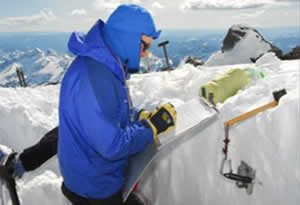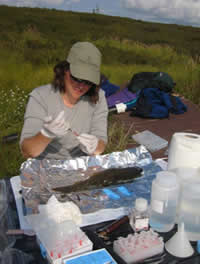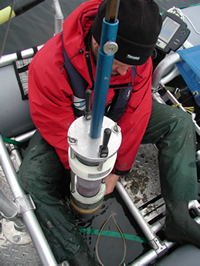Airborne Contaminants Found in Western U.S. and Alaskan National Parks
National Park Service web site
February 28, 2008
|

|
| Snow sampling at Mount Rainier National Park, Washington; photo courtesy National Park Service |
The Western Airborne Contaminants Assessment Project (WACAP) was initiated to determine the risk from airborne contaminants to ecosystems and food webs in eight core parks: six west coast and Alaska national parks (Sequoia, Mount Rainier, Olympic, Denali, Gates of the Arctic, Noatak) and two parks in the Rocky Mountains (Rocky Mountain and Glacier).
Analysis of the concentration and biological effects of airborne contaminants in air, snow, water, sediment, lichen, conifer needles, and fish was conducted from 2002 through 2007. Atmospheric transport patterns were also assessed in order to identify potential sources of contaminants to parks. Air and vegetation samples were also collected at twelve secondary parks (Bandelier, Big Bend, Crater Lake, Glacier Bay, Grand Teton, Great Sand Dunes, Katmai, Lassen Volcanic, North Cascades, Stikine-LeConte Wilderness, Wrangell-St. Elias, and Yosemite) throughout the course of the study.
Key findings from the 8 core WACAP parks:
- Measurable amounts of both current use and historic (banned in the U.S.) contaminants were found in snow, water, vegetation, fish and lake sediment at all 8 parks;
- Parks nearest agricultural areas (Sequoia, Rocky Mountain, Glacier) contained higher levels of both currently used pesticides and pesticides banned some decades ago;
- Historical records of contaminants in lake sediments showed that the ban in the U.S. (in the 70s – 90s) of several key contaminants (e.g., DDTs, dieldrin, chlordanes) has served to reduce deposition of these compounds to lake sediments in some parks further away from agricultural sources, but they are continuing to accumulate in lake sediments of many parks close to agricultural sources;
- Contaminants generally increased with elevation, so high elevation areas in parks may be at extra risk for contamination;
- Contaminant concentrations of mercury in fish in many parks exceeded risk thresholds for health impacts to fish-eating birds and mammals, while concentrations of DDT in some fish at Sequoia and Glacier and chlordanes in one fish at Glacier exceeded risk thresholds for health impacts to fish-eating birds;
- Concentrations of mercury, dieldrin, and DDT found in fish from some parks exceeded EPA human health thresholds;
- Some “intersex” fish (male and female reproductive structures in the same fish) were found in Rocky Mountain and Glacier (but not in any of the other 6 parks in the study); and
- Some “new” contaminants like PBDEs (flame retardants commonly applied to furniture fabric) show increases in deposition to park ecosystems.
The scientific investigators for the project included the Environmental Protection Agency, the US Geological Survey, the US Forest Service, Oregon State University, and the University of Washington. A final report is now available, including park-specific overviews of results for each of the 8 parks. A database containing all of the laboratory results will also be made available on the NPS WACAP website later this year.
 |
 |
| Sampling fish for contaminants at Denali National Park and Preserve, Alaska; photo courtesy National Park Service |
Sediment coring at Gates of the Arctic National Park and Preserve, Alaska; photo courtesy National Park Service |
Other pages in this section
- Beetle Outbreak Threatens Park Trees: Researchers Say Global Warming to Blame – Summer/Fall 2008
- Ranger-Guided Snowshoe Walks – November 27, 2008
- New USGS Geologic Map of Mount Mazama and Crater Lake Caldera, Oregon – November 24, 2008
- Crater Lake snow total back to average level – November 5, 2008
- Crater Lake seeks volunteers – November 3, 2008
- Rim Drive at Crater Lake closes for season – November 3, 2008
- Hands and Hoofs: Horse Group helps Crater Lake Ski Patrol mark winter trails – September 18, 2008
- Ski patrol volunteers needed at Crater Lake Park – October 10, 2008
- Parts of wilderness area, Crater Lake park reopen: Cooler weather, rain help firefighters control Middle Fork Fire – October 9, 2008
- Crater Lake facilities closing down: Crater Lake Lodge to close Sunday for the season – October 7, 2008
- Meeting set on Middle Fork Fire – September 23, 2008
- Middle Fork wildfire hits 17,869 then slows down – September 23, 2008
- Weather helps Royce Butte Fire – September 20, 2008
- Fire burns into Crater Lake: Growing Middle Fork fire spreads into remote portion of the park – September 20, 2008
- William “Bill” Hopkins – September 19, 2008
- Middle Fork blaze heads toward Crater Lake – September 19, 2008
- Rattle Fire keeps highway 138 closed for weekend – September 12, 2008
- Hiking trails closed down by wildfire – September 11, 2008
- Family fun day planned at Crater Lake – September 11, 2008
- King of Jordan, ‘Lost’ actor among celebrities at Crater Lake – September 3, 2008
- Remembering Emil, the forgotten Britt: his life was spent in the shadow of his father’s fame – August 24, 2008
- Meissner, Shelton take Crater Lake run – August 10, 2008
- The road to Crater Lake – July 27, 2008
- Crater Lake swimming chilly – July 16, 2008
- Exploring the “Other Half” of Our National Parks: Stargazing Under Protected Dark Skies – June 14, 2008
- Wildfire filling sky with smoke: Fire near Crater Lake is 1,700 acres – September 10, 2008
- Crater Lake: Taking the Plunge – September 4, 2008
- Garfield Peak trail guide – August 28, 2008
- Garfield Peak offers new vantage point to Crater Lake – August 28, 2008
- Crater Lake National Park: Trees, wildflowers, dazzling views on trail to Crater Peak – August 14, 2008
- Plenty of backcountry solitude – August 14, 2008
- Crater Lake boat tours to resume – August 13, 2008
- Crater Lake needs volunteers – August 11, 2008
- Locals Impress: Area runners win 2 short runs – August 10, 2008
- Meissner, Shelton win Crater Lake marathons – August 10, 2008
- Mazama Village to be back to normal – July 23, 2008
- Fire Contained at Crater Lake – July 22, 2008
- 50 spots remain for Crater Lake Rim Runs – July 20, 2008
- Crater Lake; Rim Drive opens today – July 11, 2008
- Crater Lake Rim Run spots going – June 24, 2008
- Crater Lake north entrance opened, but caution urged – June 21, 2008
- Many Crater Lake services open, despite snow – June 10, 2008
- A Tribute to Steve Robinson – Spring, 2008
- Crater Lake’s new boss fulfills a lifelong dream – May 04, 2008
- A Look back at history: Programs focus on history of Southern Oregon – April 25, 2008
- Crater lake has new superintendent: Craig Ackerman will move from the Oregon Caves National Monument – March 5, 2008
- Oregon law could nix proposed water agreement – March 5, 2008
- Crater Lake contaminated, new study suggests – February 28, 2008
- Airborne Contaminants Study Released Measurable Levels Detected in Twenty Western National Parks – February 26, 2008
- What to do: Crater Lake rangers guide free hikes – February 23, 2008
- Crater Lake story will air – February 9, 2008
- Park rangers undaunted by weather – February 8, 2008
- TV crew makes trek to Crater Lake’s rim – February 8, 2008
- ODOT worker hurt when tree crushes pickup truck – February 4, 2008
- TV crew headed to Crater Lake – February 6, 2008
- Park Ranger Ken Hay Retires – January 28, 2008
- Crater Lake offers 90-minute winter tours: Park rangers lead free treks in park on Saturdays – January 24, 2008
- Laurels go to retired Crater Lake official: Dinner given for former park superintendent Chuck Lundy – January 21, 2008




